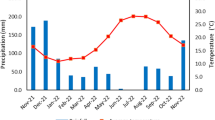Summary
The growth and development of tomato, ‘Potentate’, in sand and soil separates having a range of air capacities has been studied.
With the sand separates, an air capacity of 25 per cent gave optimum growth. Both the number of days to anthesis and the number of leaves produced before the first infloresence were negatively correlated with air capacity.
Tomatoes grown in soil separates with base fertilizer added before prickingout showed an optimum air capacity requirement of 5 per cent. Plants in similar substrates and receiving a nutrient solution at each irrigation were less responsive to differences in air capacity over the range 1.9 to 20 per cent. Differences in the air capacity of the substrate had no effect on the number of leaves produced before the first inflorescence and little effect on the number of days to anthesis.
Similar content being viewed by others
References
Agapov, A. I. and Morgunov, N. I., The ratios of the capillary and non-capillary porosity of soil as a factor in the supply of water to plants. Pochvovedenie12, 103–107 (1957). Abstract No. 551. Soils and Ferts.21 (1958).
Baver, L. D. and Farnsworth, R. B., Soil structure effects in the growth of sugar beets. Soil Sci. Soc. Am. Proc.5, 45–48 (1940).
Bremner, J. M. and Shaw, K., Determination of ammonia and nitrate in soil. J. Agr. Sci.46, 320–328 (1955).
Bunt, A. C., Some physical properties of pot plant composts and their effect on plant growth: I. Bulky physical conditioners. Plant and Soil13, 322–332 (1961).
Cavell, A. J., A rapid method for the determination of nitrogen, phosphorous and potassium in plant materials. J. Sci Food Agr.5, 195–200 (1954).
Cook, R. L. and Millar, C. E., Some techniques which help to make greenhouse investigations comparable with field plot experiments. Soil Sci. Soc. Am. Proc.11, 298–304 (1946).
Croney, D., Coleman, J. D. and Bridge, P. M., The suction of moisture held in soil and other porous materials. Road Research Technical Paper No.24, 5–8. H.M.S.O. (1952).
Erickson, E. R. and Lemon, A. E., The measurement of oxygen diffusion in the soil with a platinum microelectrode. Soil Sci. Soc. Am. Proc.16, 160–163 (1952).
Hagin, J., Note on the effect of soil aggregation on plant growth as influenced by size of pots. J. Soil Sci.79, 237–238 (1955).
Miller, A. S. and Mazurak, A. P., Relationships of particle and pore sizes to the growth of sunflowers. Soil Sci Soc. Am. Proc.22, 275–278 (1958).
Page, J. B., and Willard, C. J., Cropping systems and soil properties. Soil Sci. Soc. Am. Proc.11, 81–88 (1946).
Russell, E. J., Soil Conditions and Plant Growth, p. 335. Longmans. Green & Co. London (1950).
Yoder, R. E., The significance of soil structure in relation to the tilth problem. Soil Sci. Soc. Am. Proc.2, 21–33 (1937).
Author information
Authors and Affiliations
Rights and permissions
About this article
Cite this article
Bunt, A.C. Some physical properties of pot plant composts and their effect on plant growth. Plant Soil 15, 13–24 (1961). https://doi.org/10.1007/BF01421747
Received:
Issue Date:
DOI: https://doi.org/10.1007/BF01421747




